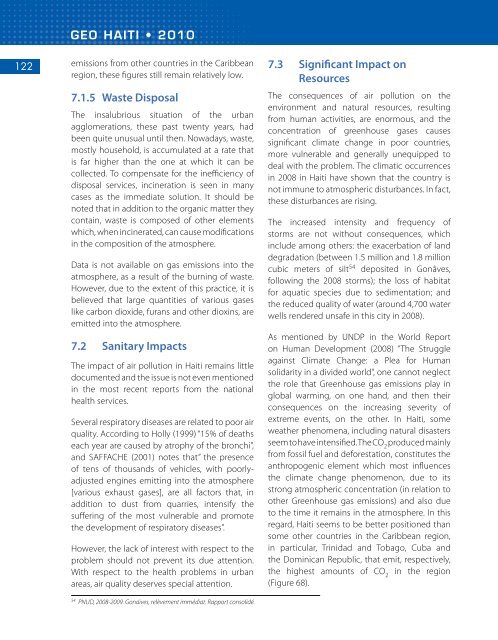GEO Haiti 2010
GEO Haiti 2010
GEO Haiti 2010
Create successful ePaper yourself
Turn your PDF publications into a flip-book with our unique Google optimized e-Paper software.
122<br />
<strong>GEO</strong> HAITI • <strong>2010</strong><br />
emissions from other countries in the Caribbean<br />
region, these figures still remain relatively low.<br />
7.1.5 Waste Disposal<br />
The insalubrious situation of the urban<br />
agglomerations, these past twenty years, had<br />
been quite unusual until then. Nowadays, waste,<br />
mostly household, is accumulated at a rate that<br />
is far higher than the one at which it can be<br />
collected. To compensate for the inefficiency of<br />
disposal services, incineration is seen in many<br />
cases as the immediate solution. It should be<br />
noted that in addition to the organic matter they<br />
contain, waste is composed of other elements<br />
which, when incinerated, can cause modifications<br />
in the composition of the atmosphere.<br />
Data is not available on gas emissions into the<br />
atmosphere, as a result of the burning of waste.<br />
However, due to the extent of this practice, it is<br />
believed that large quantities of various gases<br />
like carbon dioxide, furans and other dioxins, are<br />
emitted into the atmosphere.<br />
7.2 Sanitary Impacts<br />
The impact of air pollution in <strong>Haiti</strong> remains little<br />
documented and the issue is not even mentioned<br />
in the most recent reports from the national<br />
health services.<br />
Several respiratory diseases are related to poor air<br />
quality. According to Holly (1999) “15% of deaths<br />
each year are caused by atrophy of the bronchi”,<br />
and SAFFACHE (2001) notes that” the presence<br />
of tens of thousands of vehicles, with poorlyadjusted<br />
engines emitting into the atmosphere<br />
[various exhaust gases], are all factors that, in<br />
addition to dust from quarries, intensify the<br />
suffering of the most vulnerable and promote<br />
the development of respiratory diseases”.<br />
However, the lack of interest with respect to the<br />
problem should not prevent its due attention.<br />
With respect to the health problems in urban<br />
areas, air quality deserves special attention.<br />
54<br />
PNUD, 2008-2009. Gonaïves, relèvement immédiat. Rapport consolidé.<br />
7.3 Significant Impact on<br />
Resources<br />
The consequences of air pollution on the<br />
environment and natural resources, resulting<br />
from human activities, are enormous, and the<br />
concentration of greenhouse gases causes<br />
significant climate change in poor countries,<br />
more vulnerable and generally unequipped to<br />
deal with the problem. The climatic occurrences<br />
in 2008 in <strong>Haiti</strong> have shown that the country is<br />
not immune to atmospheric disturbances. In fact,<br />
these disturbances are rising.<br />
The increased intensity and frequency of<br />
storms are not without consequences, which<br />
include among others: the exacerbation of land<br />
degradation (between 1.5 million and 1.8 million<br />
cubic meters of silt 54 deposited in Gonâves,<br />
following the 2008 storms); the loss of habitat<br />
for aquatic species due to sedimentation; and<br />
the reduced quality of water (around 4,700 water<br />
wells rendered unsafe in this city in 2008).<br />
As mentioned by UNDP in the World Report<br />
on Human Development (2008) “The Struggle<br />
against Climate Change: a Plea for Human<br />
solidarity in a divided world”, one cannot neglect<br />
the role that Greenhouse gas emissions play in<br />
global warming, on one hand, and then their<br />
consequences on the increasing severity of<br />
extreme events, on the other. In <strong>Haiti</strong>, some<br />
weather phenomena, including natural disasters<br />
seem to have intensified. The CO 2<br />
produced mainly<br />
from fossil fuel and deforestation, constitutes the<br />
anthropogenic element which most influences<br />
the climate change phenomenon, due to its<br />
strong atmospheric concentration (in relation to<br />
other Greenhouse gas emissions) and also due<br />
to the time it remains in the atmosphere. In this<br />
regard, <strong>Haiti</strong> seems to be better positioned than<br />
some other countries in the Caribbean region,<br />
in particular, Trinidad and Tobago, Cuba and<br />
the Dominican Republic, that emit, respectively,<br />
the highest amounts of CO 2<br />
in the region<br />
(Figure 68).

















